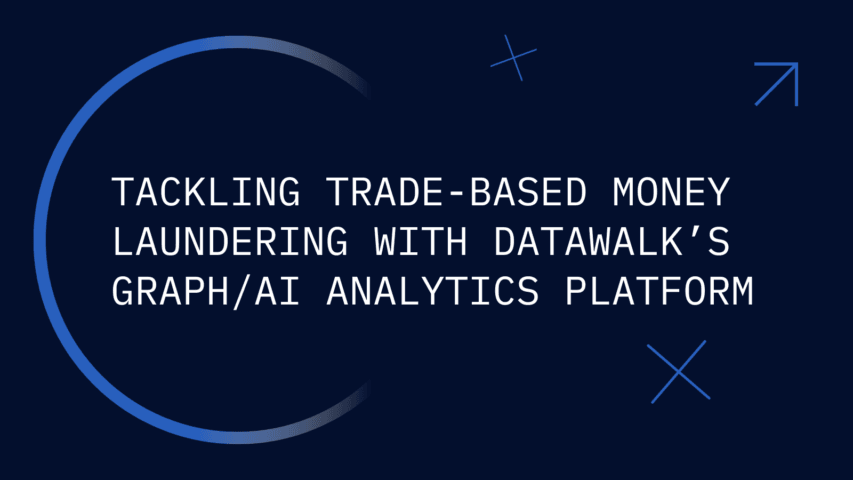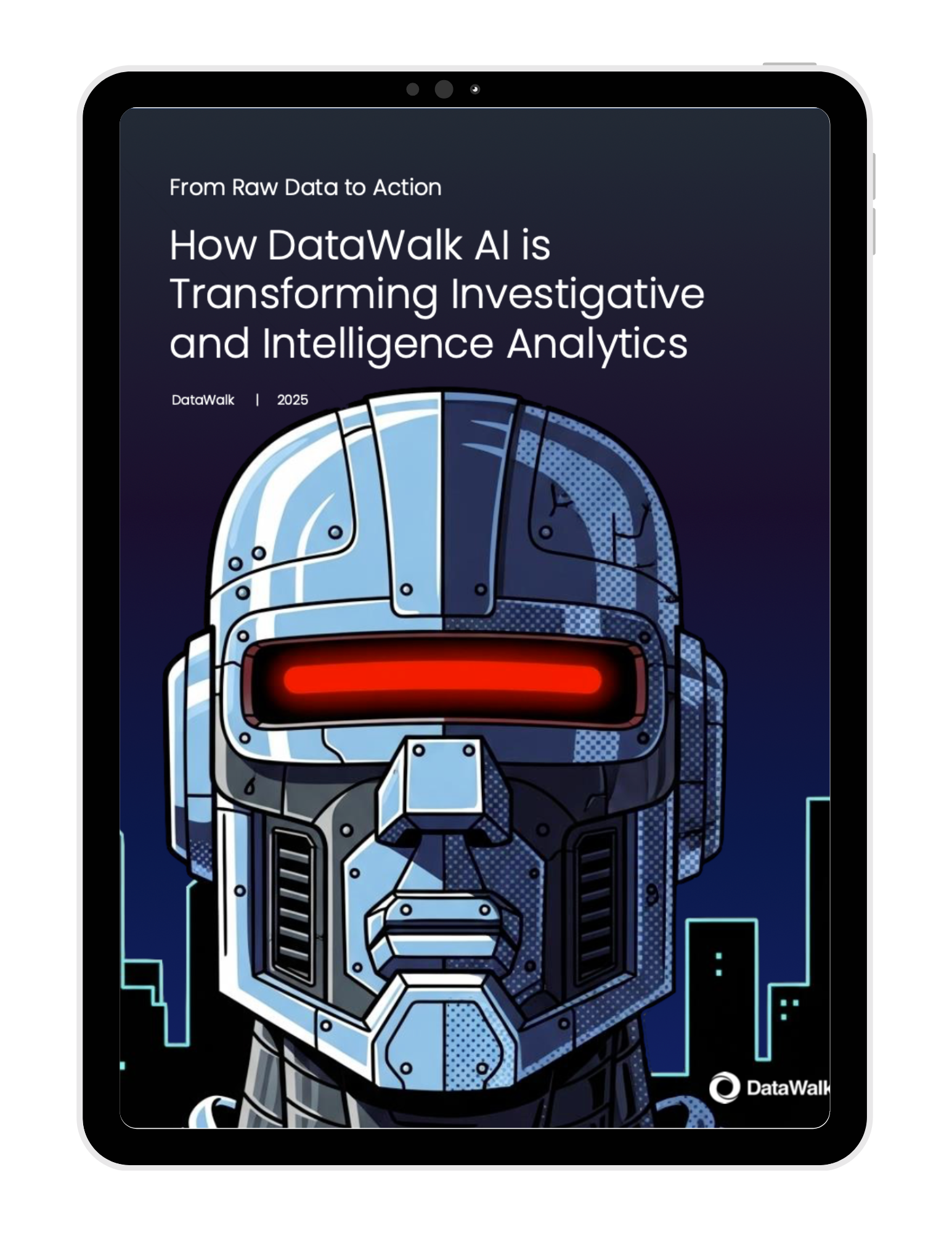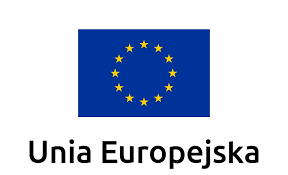
Tackling Trade-Based Money Laundering with DataWalk’s Graph/AI Analytics Platform
Trade-based money laundering (TBML) remains one of the most complex and elusive forms of financial crime. Criminal organizations manipulate legitimate trade-through mis-pricing goods, moving empty containers, forging bills of lading, or recycling invoices-to disguise illicit funds and obscure their origins. Because TBML schemes span multiple jurisdictions and involve layers of actors, documents, and transactions, traditional rule-based monitoring and manual investigative methods often fail to detect them.
To effectively counter this threat, financial institutions require technology that unifies disparate data, reveals hidden relationships, and supports rapid hypothesis testing. This technology must move beyond simple transaction monitoring to provide a holistic view of trade networks, supply chains, and financial flows. Without this comprehensive context, investigators are left trying to piece together a puzzle with most of the pieces missing.
DataWalk’s graph and AI-driven analytics platform delivers these critical capabilities, enabling financial crime teams to uncover TBML patterns and anomalies through connected, contextual, and collaborative analysis. It transforms fragmented data into a unified intelligence asset, empowering investigators to see the full picture and act decisively.
Understanding the Complexity of TBML
Detecting TBML is notoriously difficult because it hides within the enormous volume of legitimate global trade. Criminals exploit the inherent complexities of trade finance, documentation, and logistics to make their activities appear normal. Understanding these methods is the first step toward building an effective defense.
Common TBML Typologies
TBML schemes frequently involve a range of deceptive practices designed to move value across borders. These include:
- Trade Mis-invoicing: This involves over-stating or under-stating the price or quantity of goods to transfer value between colluding importers and exporters.
- Phantom Shipping: Criminals create fraudulent trade documentation for fictitious cargo that is never actually shipped, generating payments for non-existent goods.
- Document Manipulation and Multiple Invoicing: A single shipment can be invoiced multiple times using forged documents, allowing criminals to justify numerous payments for the same goods.
- Circular Letters of Credit: Complex schemes are designed where letters of credit are passed through a series of shell companies, often in different jurisdictions, to obscure the ultimate beneficiary and source of funds.
- Commodity-Based Trade Manipulation: Exploiting commodities with volatile pricing or those that are difficult to value, such as diamonds or art, to justify large value transfers.
These schemes leverage shell companies, complicit freight forwarders, and document forgers to move funds under the guise of legitimate commerce, making them incredibly difficult to isolate using traditional methods.
Network Complexity and Data Challenges
Effective TBML detection requires mapping complex networks of actors, including importers, exporters, intermediaries, and financial institutions. Investigators must understand the services and instruments they exploit, such as trade finance instruments, cross-border payment channels, and commodities. This relies on correlating data from siloed sources like transaction logs, customs records, beneficial-ownership registries, and commodity pricing databases. The manual effort to collect, clean, and connect this data is a significant bottleneck for investigative teams.
Modern Investigation Strategies
To overcome these challenges, modern investigation strategies must be data-driven and analytical. Key approaches include comparing invoice values to market benchmarks, identifying reused shipping documents, flagging unusual third-party payments, and monitoring shipments routed through high-risk free-trade zones. Most importantly, investigators need to trace beneficial ownership structures to uncover the true individuals behind complex corporate veils. Network analytics is central to this effort, revealing hidden connections that simple data queries would miss.
How DataWalk Supports TBML Investigations
DataWalk provides a purpose-built platform to address the core challenges of TBML investigations. By integrating data, enabling visual analysis, and leveraging AI, it empowers teams to move from reactive, manual processes to proactive, intelligence-led operations.
Unified Data for a Single Source of Truth
TBML detection depends on connecting trade finance data, payment transactions, customs declarations, and ownership records. DataWalk’s no-code data ingestion and knowledge graph unify these sources into a single, trusted environment. This eliminates the manual, fragmented data-gathering process that slows investigations. With all relevant data linked and entity-resolved, teams gain a 360-degree view of relationships and transactions, making it easier to connect disparate evidence and identify patterns across silos.
Visual Discovery and Hypothesis Testing
Graph analytics lies at the heart of TBML detection. DataWalk enables teams to visually explore the relationships between import-export companies, intermediaries, shell entities, and accounts. Through link charts and interactive graph navigation, investigators can uncover suspicious clusters and follow flows of funds or goods across jurisdictions. Complex TBML typologies, such as circular letters of credit or phantom shipments, can be surfaced intuitively.
Analysts can run shortest-path analyses to trace fund flows or use clustering algorithms to reveal interlinked entities. The ability to test scenarios or rules without coding allows teams to quickly experiment with hypotheses such as “flag shipments routed through high-risk free-trade zones” or “detect invoices deviating from market pricing.” Each analytical step is logged, reversible, and auditable, supporting transparent and repeatable investigations.
AI-Driven Anomaly Detection and Pattern Recognition
DataWalk’s graph-based AI and machine-learning capabilities enhance TBML detection by identifying subtle or emerging risks. The platform enables the creation of enriched analytical features (e.g., price-to-market ratios, shipment route consistency, beneficial-ownership overlap) and supports multiple AI techniques. Graph embeddings and clustering algorithms reveal previously hidden relationships, while explainable AI ensures detected patterns can be validated and justified to regulators. These tools help identify anomalies such as duplicate invoices, document reuse, or inconsistent third-party payments, without requiring data-science expertise.
External Verification and Contextual Enrichment
DataWalk’s API and App Center make it possible to integrate external datasets-such as vessel-tracking feeds, port records, commodity price indexes, or OSINT sources-directly into the investigative workflow. By cross-referencing these external inputs with internal trade and payment data, investigators can quickly identify potential phantom shipments, fictitious trades, or pricing manipulation. The result is richer context and faster confirmation of suspicious activity.
Collaborative and Secure Investigations
DataWalk supports collaborative casework across AML, KYC, and trade finance teams. Analysts can share case dashboards, comment on findings, and work from a common dataset while maintaining strict access controls. Granular permissions ensure sensitive information is visible only to authorized users. By enabling real-time collaboration in a controlled environment, DataWalk reduces dependency on IT, accelerates case resolution, and ensures consistent, secure sharing of insights across financial crime units.
Key Benefits of the DataWalk Approach
By directly addressing the primary obstacles in TBML investigations, DataWalk delivers tangible benefits that enhance efficiency, effectiveness, and adaptability.
Overcoming Manual Data Gathering
The challenge of manual data gathering across silos is a primary source of delay and missed insights. DataWalk solves this with its entity-resolved knowledge graph, which unifies disparate data sets to provide a 360-degree view of all entities and transactions, effectively eliminating data silos.
Empowering Analysts without Technical Expertise
Investigations should not be bottlenecked by a dependence on technical specialists. DataWalk’s no-code data fusion, visual queries, and prototyping tools enable analysts to explore data, build scenarios, and test hypotheses independently, without needing to write code.
Accelerating Hypothesis Testing and Scenario Analysis
Slow or incomplete hypothesis testing leaves institutions vulnerable. DataWalk’s graph algorithms and intuitive search allow for rapid, iterative analysis and scenario evaluation. Queries can be easily edited, reversed, and shared, fostering a dynamic and agile investigative process.
Uncovering Hidden Risks and Connections
The inability to connect related risks across entities is a critical failure point. DataWalk’s link charts and graph analytics excel at revealing hidden connections, suspicious clusters, and complex criminal networks, such as those involving shell companies or circular letters of credit.
Adapting to Evolving TBML Typologies
Criminals constantly develop new methods, and investigative tools must adapt. DataWalk’s no-code prototyping and AI/ML capabilities support the rapid testing of new rules and algorithms, while the flexible knowledge graph allows new data sources to be integrated quickly to counter emerging threats.
Fostering Secure, Cross-Functional Collaboration
Limited collaboration between AML, trade finance, and other functions creates blind spots. DataWalk’s granular permission controls and investigation sandbox enable teams to share cases and insights securely, ensuring coordinated efforts while protecting sensitive data.
Conclusion
Trade-based money laundering undermines the integrity of global trade and financial systems by embedding illicit activity within legitimate commerce. Detecting it requires more than transaction monitoring-it demands unified data, connected context, and advanced analytics that can reveal sophisticated criminal networks operating at scale.
DataWalk equips financial crime teams with those capabilities. Its knowledge graph integrates trade, transactional, and ownership data; its visual exploration tools and graph algorithms expose hidden connections; and its AI modules enable rapid detection of anomalies. Together, these capabilities transform TBML investigation from a manual, fragmented process into an agile, intelligence-driven operation that adapts to emerging risks and strengthens institutional resilience.

FAQ
Join the next generation of data-driven investigations:
Discover how your team can turn complexity into clarity fast.

Solutions
Product
Partners
Company
Resources
Quick Links



